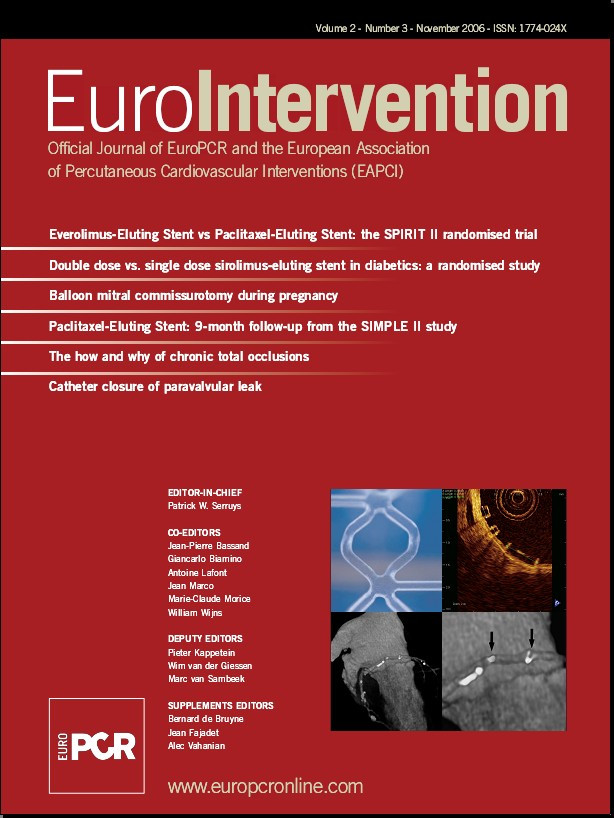After years of careful planning and the extensive and inspired groundwork developed between the leadership of Working Group 10, EuroPCR and the European Society of Cardiology (ESC), the EAPCI – the European Association for Percutaneous Cardiovascular Interventions – has seen the light of day. The mission of this new association, the EAPCI, is “to reduce the burden of cardiovascular disease in Europe through percutaneous cardiovascular interventions”.
After its official launch, following approval by the ESC General Assembly at the World Congress of Cardiology 2006 in Barcelona, Spain, the EAPCI has been quickly evolving as the platform for clinical and scientific exchange between all health care professionals involved with percutaneous cardiovascular interventions. These endeavours have grown out of a synergy between many elements, among which is notably this journal itself, along with the EuroPCR course and all activities of the former Working Group 10.
In practical terms, the creation of our association involves certain specific activities. To begin with, the EAPCI will actively contribute to the programme of the yearly EuroPCR course, which will become our official annual meeting. This journal, EuroIntervention, is the official organ of our association, and will continue in its goal of presenting the best of research and education in the field, including case presentations in the lively electronic format that you are becoming used to. Furthermore, the EAPCI will dedicate a large part of its energy and time to training, accreditation and Fellowship programmes.
In order to achieve its goals, EAPCI will rely entirely on a close collaboration with the national Working Groups of invasive cardiology throughout Europe, as well as abroad, aiming at improving the quality – and recognition – of interventional practice and care throughout the continent and internationally.
Lastly, the EAPCI will underline our will and vigour in integrating and contributing to all other activities of the ESC, as they pertain to revascularisation and other percutaneous interventions. Needless to say, the European Association for Percutaneous Cardiovascular Interventions, EAPCI, will continue to contribute to the annual ESC congress, the FOCUS sessions, the Euro Heart Survey programme, as well as the preparation and implementation of Guidelines. And this is just the beginning.
Underlining all our activities, the EAPCI will work on fostering a mature, active and measured collaboration with industry partners, one that is based on a clearly defined code of conduct acceptable to all. Post-graduate education, improving patient access to device-based therapies and promoting clinical research represent obvious areas of common and shared interest between us and the industry, and we recognise the symbiotic relationship that we share with them.
The leadership of the EAPCI is comprised of an executive board, the various chairs and co-chairs of the different EAPCI committees as well as advisors from the European Society of Cardiology and Europa Organisation.
All members of the former ESC Working Group on Interventional Cardiology will have their membership automatically transferred, pending their approval, as required by French law. For others who are now interested in joining EAPCI, let me take this opportunity to invite you all to fill out the membership form, located on our website (go to escardio.org or europcronline.com). Needless to say, EAPCI is open to all medical and allied professionals whose main activity is percutaneous cardiovascular intervention, irrespective of their specialty and country of citizenship. I trust that you will be keen on joining an Association which, with your collaboration, will become the core of our professional life in the years to come.
This is our first official column, it is the start of a long process that has, itself, been born out of the research, the work, the dedication of many of you in our young and fast growing speciality. We look forward to sharing the future together.
Executive Board
President: Dr. W. Wijns, FESC, Belgium
President-Elect: Prof. C. di Mario, FESC, United Kingdom
Past Chairman: Prof. A. Lafont, FESC, France
Secretary: To be elected
Treasurer: To be elected
Editor-in-Chief of EuroIntervention Journal (ex-officio): Prof. P. Serruys, FESC, The Netherlands
EuroPCR Board of Directors: Prof. A. Vahanian, FESC, France
EuroPCR Board of Directors: Dr. J. Fajadet, France
Presently the EAPCI Board is organising the elections of the new Board members, including the Secretary and the Treasurer.
Chair & Co-Chair of EAPCI Committees
Communication Committee
Chair: A. Baumbach, United Kingdom
Co-Chair: B. Chevalier, France
Euro Heart Survey Committee
Chair: F. Weidinger, Austria
Co-Chair: J. Marco, France
Scientific Initiatives Committee
Chair: F. Eberli, Switzerland
Co-Chair: R. Kornowski, Israel
National Membership Committee
Chair: J. Fajadet, France
Co-Chair: S. Silber, Germany
Education Committee
Chair: J. Marco, France
Co-Chair: A. Cremonesi, Italy
Fellowship Committee
Chair: A. Lafont, France
Co-Chair: J. Nordrehaug, Norway
Accreditation Committee
Chair: C. Di Mario, United Kingdom
Co-Chair: A. Vahanian, France
Clinical Initiatives Committee
Chair: M. Thomas, United Kingdom
Co-Chair: M. van Sambeek, The Netherlands
ESC and Europa Organisation Advisors
CEO: A. Howard, France
Operations Director for EAPCI: K. Deront, France
CEO Europa Organisation: M. Doncieux, France

